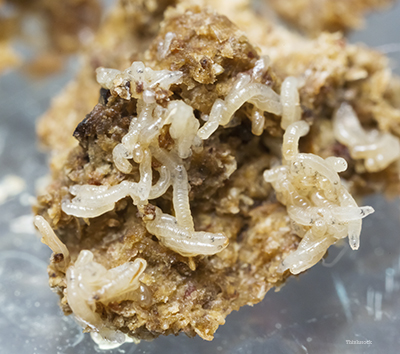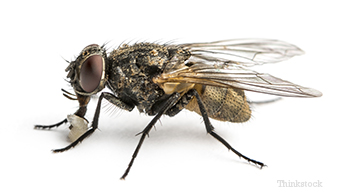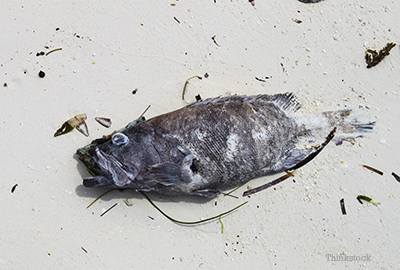In recognition of Pet Health Network’s campaign -- Beware the Bug: Parasite Prevention and Screening for Dogs -- we asked a panel of veterinarians what they believed to be the three “creepiest” parasites that they had seen affecting pets. What they came up with, based on firsthand experience, made us cringe. Remember, if your pet is showing any signs of an infestation, be sure to contact your veterinarian as soon as possible; each of these parasites poses a serious threat to their health.
#1. Maggots One of the most well-known parasites, the term “maggot” specifically refers to the larvae of a fly, but many people refer to maggots as the larvae of any insect. 1
One of the most well-known parasites, the term “maggot” specifically refers to the larvae of a fly, but many people refer to maggots as the larvae of any insect. 1
Pets confined outside, and weak or debilitated pets are especially tempting targets for flies to lay eggs on. In pets, maggots are known to feast on any dead or dying tissue, specifically any type of draining wound or dirty coat. This process is called Myiasis and becomes very dangerous because once the maggots begin feasting on decaying tissue, they may continue to eat away at healthy tissue. Due to their destructive nature, maggots are surely one of the most unsettling parasites.
1.http://www.oxforddictionaries.com/us/definition/american_english/maggot
#2. Cuterebra
Cuterebra, an “opportunistic parasite” according to MerckManuals.com, is the larvae of the Cuterebra fly. In essence, it’s a maggot, but a very specific and unsettling kind. It uses small animals as hosts to complete its life cycle, explains Dr. Phil Zeltzman, who goes on to say, “the usual hosts are rodents or rabbits; however, the eggs or hatched larvae can stick onto a dog or cat if they pass by.”
larvae can stick onto a dog or cat if they pass by.”
The adult Cuterebra fly does not feed on animals; its larvae are hatched on the animals’ body after eggs are deposited and stuck to the host. Following their initial hatching, and as a result of the added body heat, the Cuterebra larvae enter the body through either the nose, mouth, or an open wound. They then burrow into the skin and begin to grow.
Once in the skin, the parasites can grow to as much as an inch long. A small breathing hole appears in the cyst where it lives, and you may even see the head poking out. Dr. Bill Saxon (DVM, DACVIM, DACVECC) adds, “The fact that this parasite goes undetected until it emerges from under the skin of an animal is like something out of the movie Alien,” which certainly makes it worthy of a placement on our list of creepiest parasites.
Surprisingly, while the Cuterebra is unnerving, it’s their absence that poses a greater risk to the pet. Eventually, they leave their cyst and expose an open wound with damaged tissue that is very susceptible to infection. Be sure to bring your pet in to see a veterinarian right away if you feel any new lumps or bumps; the parasite should be removed by a professional to minimize the risk of future infection!
#3. Dioctophyme renale, the giant kidney worm
Rounding out our list of the creepiest parasites is the Diotophyme renale, frequently shortened as the D. renale – the giant kidney worm. While mink are cited as the most common host by MerckManuals.com, any mammal can become infected after ingesting their larvae in raw fish, frogs, or by directly ingesting an infected annelid worm.
As detailed by the University of Michigan, “Dioctophyma renale eggs are laid in the kidneys of the definitive host and passed to the urinary bladder. They need two weeks to three months in water, depending on temperature, to embryonate.” The eggs will only develop in an intermediate host (like fish). Then, if the fish is ingested by a dog or cat they’ll migrate from the intestine to the kidney and reach the reproductive phase of their lifecycle.
Then, if the fish is ingested by a dog or cat they’ll migrate from the intestine to the kidney and reach the reproductive phase of their lifecycle.
Dr. Peter Kintzer (DVM, DACVIM) confirms, “After ingestion, the juvenile worm migrates to one of the kidneys. There it can grow to considerable size (hence the name) resulting in fibrosis and destruction of the kidney.” The University of Michigan adds that the worm could grow to 100 cm and wreck havoc on a dog’s kidney.”
Although this infestation is very rare, the effects are usually fatal. It will destroy the kidney at varying speeds and is extremely difficult to detect. This worm has definitely earned a place among the creepiest parasites.
If you have any questions or concerns, you should always visit or call your veterinarian -- they are your best resource to ensure the health and well-being of your pets.
